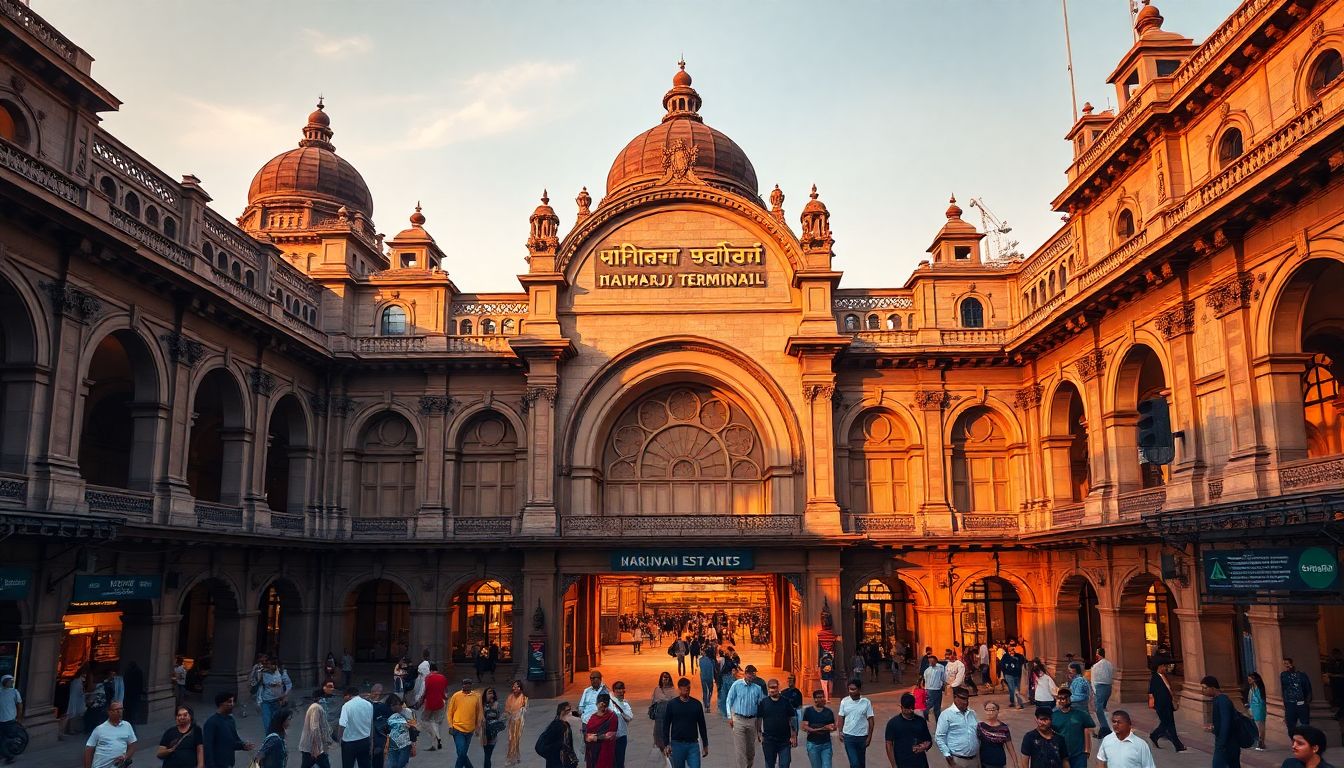- Get link
- X
- Other Apps
- Get link
- X
- Other Apps
Chhatrapati Shivaji Maharaj Terminus: A Majestic Landmark of Mumbai

Chhatrapati Shivaji Maharaj Terminus: A Majestic Landmark of Mumbai
Chhatrapati Shivaji Maharaj Terminus (CSMT) stands as a brilliant jewel in Mumbai's vibrant landscape. With its intricate design and bustling atmosphere, this historic landmark tells the story of a city that never sleeps. The terminus, a key transportation hub, links millions of commuters daily and serves as a gateway to the rich culture and history of Mumbai. Recognized as a UNESCO World Heritage Site, CSMT embodies the spirit and identity of a city that thrives on diversity and resilience.
Architectural Marvel: A Fusion of Styles
Indo-Saracenic Architecture: A Detailed Look
CSMT is a stunning example of Indo-Saracenic architecture, which merges Islamic and Gothic styles. Key features include:
- Arched Windows: These allow natural light to fill the vast space inside, creating a welcoming ambiance.
- Dome Structures: The central dome reaches a height of 90 feet, symbolizing grandeur.
- Intricate Stonework: The finely carved details on the façade display exceptional craftsmanship.
Experts in architecture praise CSMT for its harmonious blend of styles and its artistic significance to India.
The Influence of Victorian Gothic Design
Victorian Gothic influences grace the terminus, adding to its historical richness. Elements like:
- Towering Spires: They punctuate the skyline and invoke a sense of majesty.
- Gargoyles and Statues: These mythical creatures serve as water spouts while enhancing the station's whimsical character.
The combination of these styles creates an aesthetic that stands the test of time.
Symbolic Elements and Their Meanings
Various architectural elements hold deep symbolic meanings. For instance:
- Statues of Historical Figures: Remind visitors of India's rich history.
- Ornate Carvings: These often depict flora and fauna, connecting the structure to nature.
Research shows that these symbols add layers of meaning, reflecting the cultural tapestry of Mumbai.
A Historical Journey: From Construction to Present Day
The Construction Process: Challenges and Triumphs
Construction began in 1878 and faced many hurdles, including:
- Funding Issues: Initial budgets often went over due to unexpected costs.
- Labor Shortages: Recruiting skilled craftsmen was a challenge.
Despite these challenges, the terminus was completed in 1888, marking a significant achievement in Mumbai's infrastructure development.
Evolution Through Time: Key Milestones
CSMT has seen many changes over the years, including:
- Renovations: Major restorations occurred in the late 20th century to preserve its charm.
- Historical Events: The terminus played a role during India’s independence movement, symbolizing hope and determination.
Historical photos showcase the evolution of CSMT, reflecting its lasting significance.
The Terminus in Popular Culture
CSMT has a vibrant presence in films and literature. Movies often feature its architectural beauty, making it a backdrop for stories of love and struggle. Notable films, like "Chennai Express," have showcased the station's grandeur, enhancing its cultural relevance.
Navigating the CSMT: A Traveler's Guide
Getting There and Around: Transportation Options
Traveling to CSMT is straightforward, with various options:
- Train: The terminus connects to local and long-distance trains.
- Bus: Numerous bus routes serve the area, making it accessible.
- Taxi and Auto-Rickshaws: Easily available for short distances.
For travelers with disabilities, ramps and designated pathways ensure accessibility.
Inside the Terminus: Key Features and Facilities
Visitors can enjoy several features within CSMT:
- Grand Waiting Areas: Comfortable spaces for passengers to relax.
- Food Stalls and Shops: Offering local snacks and souvenirs.
- Information Desks: Helpful staff assist travelers in planning their journeys.
This blend of functionality and comfort makes CSMT a welcoming hub.
Safety and Security Measures
Safety is paramount at CSMT. The station has:
- CCTV Surveillance: To monitor activity within the premises.
- Security Personnel: Present at strategic locations to ensure passenger safety.
Travelers should always be mindful of their belongings and follow safety protocols.
The Cultural Significance of CSMT
Its Role as a Social Hub
CSMT is more than just a transit point; it acts as a social meeting ground. People gather here, sharing stories and experiences, making it a lively space. Sociological studies highlight the importance of such hubs in urban life, showing how they foster connections among strangers.
The Terminus as a Symbol of Mumbai's Identity
Over the years, CSMT has become synonymous with Mumbai. This landmark represents the city’s resilience, history, and growth. Cultural commentators note how it encapsulates Mumbai's spirit, bringing together diverse populations and ideas.
Preservation Efforts and Future Plans
Efforts to preserve the terminus are ongoing. Authorities are focused on maintaining its architectural integrity while modernizing facilities. Future plans include enhancing amenities for tourists and commuters alike, ensuring CSMT remains relevant and enchanting for generations to come.
Conclusion: A Timeless Landmark
Chhatrapati Shivaji Maharaj Terminus stands tall as a testament to Mumbai's rich heritage and vibrant culture. Its architectural beauty, historical significance, and role as a social hub make it an iconic landmark. As we look ahead, CSMT will continue to thrive, reminding us of the past while embracing the future. Visiting this majestic terminus is not just a journey through time but a celebration of Mumbai's spirit.
- Get link
- X
- Other Apps
Comments
Post a Comment